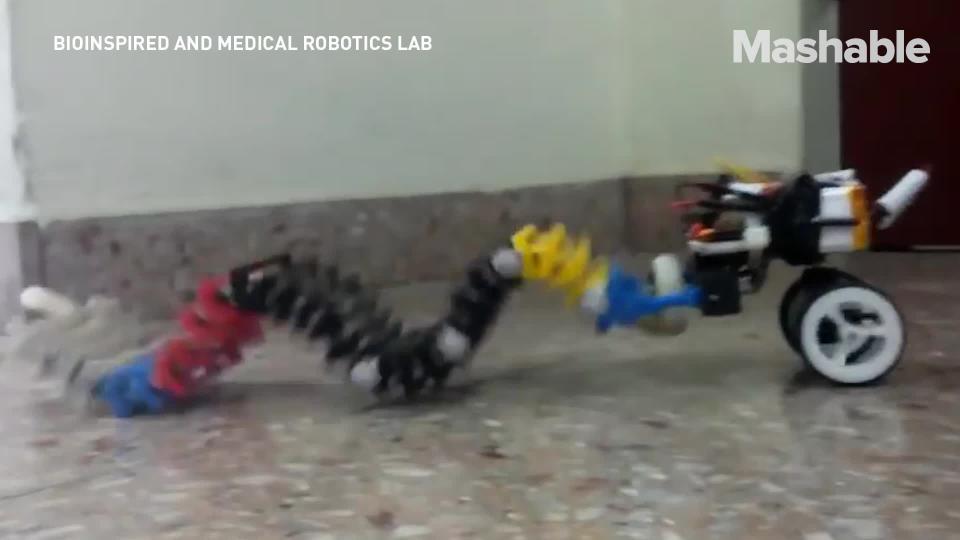Scientists just fit a GIF onto DNA, which might be the most important thing to ever happen to GIF-kind

GIFs are the fundamental building blocks of our digital existence. Whether they are in texts, tweets, or articles, GIFs are now a staple of how we communicate in the modern world.
But now GIFs are making their way to a new frontier: scientists have finally figured out how to store and retrieve them from bacterial DNA.
SEE ALSO: A new video shows you exactly what it looks like when DNA replicates
Researchers at Harvard Medical School used CRISPR, a new, incredibly precise and relatively cheap gene sequencing tool, to encode Eadweard Muybridge's 19th Century animation of a running horse, essentially the world's first GIF, inside bacterial DNA. (Writers note: NyanCat would have been our choice.)
While putting the animation on DNA is a feat within itself, impressively (and perhaps more importantly) researchers only made a few errors while sequencing the bacteria's genome to recreate the running horse. This means that the recording DNA can capture and replay events in the order in which they occurred. Their work, which was funded by the National Institutes of Health, was published this week in the journal Nature.
While this sounds like a breakthrough for GIF kind — after all, we can't recall a GIF being used in quite this way before — there are much larger implications medical science here.
"The point is not to store videos in bacteria," said Harvard Medical School neuroscientist Seth Shipman, in a video interview.
"We used the video because it's a good example of a complex piece of information that has both many parts to it (that is, many pixel values) and a time component that was organized over time. So, it was a good way for us to test if the CRISPR adaptation system that we're using could actually acquire enough information that we could go in and sequence the bacteria after we had encoded it and reconstruct the movie."
Shipman and his team's choice of a GIF as DNA storage test media is not surprising when you look at their long-term goal of biological recording.
Scientists can only see so far into their human body and its systems. No one knows, for instance, how neurons, which start out unspecialized in young brains, develop into distinct types of neurons.
But what if a cell with access to the brain could watch and record that development from day one and then, when the brain is matured, be extracted and, through CRISPR genome sequencing, play back the entire evolution of a neuron? It's only a start but this bacterial-encoded gif could be on small step toward making that dream a reality.
To test the time-based recording capabilities of biological DNA, Shipman's team fed in to the bacterial DNA strands the galloping horse GIF frame-by-frame over the course of five days.
As Shipman explained it in the video, the frames were all retrieved in their proper order, which means they could play back the GIF and still see the galloping horse, not a disjointed jumble of events. The system "captures the timing information of different molecular events," he said.
DNA typically stores the blueprint of biological organisms, but scientists have, in recent years, started investigating its data storage capabilities, especially the notion that you can store vast amounts of data in a molecule-sized space. Plus, when DNA is separated from a living organism, or that organism dies out around it, and the DNA dries out and is protected from the light (as it is in fossils), that data can be retrieved thousands of years later.

Image: Harvard Medical School
Recent studies, though, have focused on synthetic DNA, which allows for similar storage in tiny spaces capabilities, but without the concern of data longevity outside an organism and in the light.
Last year researchers stored an entire OK Go music video on synthetic DNA and earlier this year, scientists at Columbia University stored and retrieved megabytes of data on synthetic DNA. Both methods, though were time-consuming and expensive. The integration of the CRISPR system holds out the promise of affordable and accurate storage and retrieval from biological systems.
"This recent result is pretty exciting in that it used genomic DNA editing techniques to 'log' data and store it in a cell's genome," said Luis Ceze, an associate professor of computer science and engineering at the University of Washington who worked on the OK Go DNA Storage project. "This can enable cell-based 'living sensors' that log information."
Ceze added, though, that the Harvard team's work is no way competitive with synthetic DNA storage systems. While Ceze hopes to build DNA-based storage that one day rivals our best Solid-State Drives, Shipman's work is about recording tiny bits of data in sequence within a cell. "You would not use it to store movies, but I would use synthetic DNA to store movies," said Ceze.
Ultimately, researchers want to place these engineered cells inside living organism where they can automatically record events (or changes) and then remove the smart cells and decode the DNA-stored information for full, sequential play back. The currently technology, however, required Shipman's team to manually enter the information. No one has trained the DNA and host cells to record on their own.
But that time is coming and, someday, our cells may be grabbing viral moments, literally, and playing them back as GIFs (or more).
WATCH: This robot that can do 'the worm' could one day perform colonoscopies


